Classification
By Mary Bigelow
Posted on 2009-03-30
 Classifying Classification describes how a team of first-grade teachers examined their own instruction in classification and how it related to their state standards. Check out the rubric they created and how it could be adapted for older students. They also have a continuum for classification activities: matching, sorting, categorizing, and interpreting. I wonder how many teachers of older students repeat these activities without knowing what the students have done in the younger grades? Are we challenging students along a continuum or doing the same level of activities again and again?
Classifying Classification describes how a team of first-grade teachers examined their own instruction in classification and how it related to their state standards. Check out the rubric they created and how it could be adapted for older students. They also have a continuum for classification activities: matching, sorting, categorizing, and interpreting. I wonder how many teachers of older students repeat these activities without knowing what the students have done in the younger grades? Are we challenging students along a continuum or doing the same level of activities again and again?
The SciLinks database has some good resources and lesson ideas on the topic at the K-4 level. Websites for the middle grades and high school can be accessed by entering classification as a keyword for lists of websites related to classification systems, classification of rocks, and the basis for classification.
The students’ activities described in Shark Teeth helped them to learn that scientists classify for a purpose. And the authors describe how the students also learned how to use the graphing feature of Excel (with which many adults struggle!). The SciLinks keyword sharks has websites listed for grades 9-12, but you can preview and select any that would be appropriate for your students or as background information for yourself.
We often think of classification in terms of living things, but Does Light Go Through It? shows that even very young children can describe patterns and characteristics. I think that even older students would understand vocabulary such as opaque, transparent, and translucent if they have some hands-on experiences to explore the concepts.
The February issue of Science Scope has a “Classification” theme also. Many of the activities in that issue could be adapted for younger (or older) students. I’ve found that with any of these classification activities, the point is not for students to get a “correct” answer. The real value is in the discussions students have about the similarities and differences of the objects and in the teacher’s guidance through the processes. You can learn a lot by listening and guiding when necessary as students develop their skills in observation, description, measuring, graphing, summarizing via their journals, and making connections.
My experiences at an Orioles game will never be the same after reading What Makes a Curveball Curve. Check out SciLinks for websites describing and investigating the science behind many sports.
 Classifying Classification describes how a team of first-grade teachers examined their own instruction in classification and how it related to their state standards. Check out the rubric they created and how it could be adapted for older students.
Classifying Classification describes how a team of first-grade teachers examined their own instruction in classification and how it related to their state standards. Check out the rubric they created and how it could be adapted for older students.
Science activities in early childhood prepare for a lifetime of learning
By Peggy Ashbrook
Posted on 2009-03-30
Like learning to count or to read, learning how to do science is a process. Children of all ages benefit from exposure to “science” situations where they are encouraged to fully experience our world, describe what they see, count and record data, ask questions about the experience, repeat the experience, and think and talk about the why of it. If we want children to become life-long questioners and perform well on standardized tests when they are in high school, we need to include science in their early childhood curriculum where direct experience with different materials and an encouraging environment develop their beginning ideas about the natural world and their exploration confidence.
Science activities can be designed to encourage children to make predictions about what they think might happen. Questions such as “What do seeds need to sprout?” “What will happen to this object in water?” and “What is attracted to a magnet?” are common topics in preschool. After seeing what does happen, children can share their thoughts, informally or formally, and record them by drawing, writing, recording on a chart, and dictating. Once is usually not enough for engaging experiences, and repeating the process is part of scientific inquiry. Later that day, the next week or even months later, children will recall what they did and talk about why they think they saw the results that they did.
Today I saw a K-1 class mixing pinches of turmeric, paprika, and dirt into small dabs of egg yolk, oil, and water. (Safety note: Remind the children to keep hands and brushes out of their mouths and be sure to wash hands afterward.) They talked as they worked, noticing differences in all six materials and how the dry powders mixed into the liquids. The objective was to determine which mixture would be most suitable as paint.

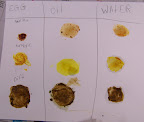
(Click on the photos to enlarge.)
This structured investigation inspired a lot of discussion and wondering. I wonder at what levels the children will use this background to support future learning about differences between oil and water, the composition of foods, and how to preserve works of art.
Peggy
Like learning to count or to read, learning how to do science is a process. Children of all ages benefit from exposure to “science” situations where they are encouraged to fully experience our world, describe what they see, count and record data, ask questions about the experience, repeat the experience, and think and talk about the why of it.
Professional development on a shoestring
By MsMentorAdmin
Posted on 2009-03-30
Our district professional development budget is being drastically reduced next year. Each department has been asked how to provide professional development on a shoestring. Do you have any suggestions for our science department?
–Lisa, Montgomery, Alabama
There are those who suggest that reduced professional development (PD) budgets in many-if not most-schools districts may not be as terrible as many think. Schools may have to reconsider the single events in which a well-knows speaker blitzes in for a few hours, gives a speech, and leaves without any follow-up activities to support the teachers or to determine if anything changes in the classrooms as a result.
Take a look at the National Staff Development Council’s new report, Professional Learning in the Learning Profession. The report summarizes the research on the relationships between PD and student learning and describes how effective PD should
- Be intensive, ongoing and sustained over time, and connected to practice.
- Focus on student learning and address the teaching of specific curriculum content.
- Align with school improvement priorities and goals.
- Build strong working relationships among teachers.
This is your chance to tailor PD to the needs of your science teachers, rather than trying to fit your colleagues into one-size-fits-all events. First, ask your administrator for state or local PD requirements and the district views on independent study and teacher-directed activities. Find out what types of pre-approval and documentation are required for these nontraditional activities.
Then survey the science teachers to identify their needs in content knowledge and instruction. Ask them to examine the curriculum and state standards to identify science topics in which they need background knowledge or cutting-edge topics for which they would like more information. And look at areas in which your students are struggling. Most districts offer general workshops in instructional skills, but you now have a chance to identify specific skills your science teachers need such as inquiry, lesson design, notebooks, formative assessments, laboratory procedures, cooperative learning, reading/writing in science, inclusion, technology, or classroom management. The result of your survey should be a set of goals reflecting the needs of your teachers, PD activities to meet those needs, and a description of how you will chart your progress toward meeting the goals.
You can find or create a variety of free or low cost PD activities: teacher-directed study groups, blogging, action research projects, independent study, presentations by your own teachers (ideally, they should receive a modest stipend), online courses, collaborations with other school districts (including videoconferencing) whose teachers have similar needs, events at nearby museums or science centers, and online collaborations with other science teachers via discussion groups or networking sites. Rather than putting together an extensive list of unrelated events, be sure your activities are connected to your identified needs and goals.
If your district does not have guidelines for personalized PD plans, the NSTA Learning Center has a “PD Plan and Portfolio” tool to guide you through this process, enabling you to record events and evidence and produce a report that can be shared with colleagues and administrators. The Learning Center has other resources for individual teachers or study groups available online:
- Web Seminars: live online discussions (1.5 hours) with content experts and educators from around the world (free and archived for later use).
- Science Objects: online “content refreshers” (2 hours) with graphics and animations on a variety of topics (free).
- SciPacks: online courses (10 hours) that include an assessment, support from a facilitator, ideas for classroom use, and a certificate of completion ($31.99 for NSTA members, $39.99 for nonmembers).
- SciGuides: online teaching resources that include web-based resources, lesson plans, and examples of student work (some are free, others are $4.95 for NSTA members, $5.95 for nonmembers).
The Learning Center also has a searchable list of books, book chapters, and archived journal articles that could be used in discussion groups or for independent study (journal articles and many book chapters are available for free or at minimal cost to NSTA members and nonmembers).
NSTA Communities is a new member resource. You can communicate with science teachers all over the world, share resources, join groups of like-minded teachers, and find educators in your geographical area with skills and knowledge they are willing to share. And you can offer your skills and advice to others.
Don’t forget to work with your administrators to design a format for reporting not just the topic and the hours but also a discussion of how these activities have improved teachers’ content knowledge and instructional skills. Invite administrators to your events and into the classrooms to see the results.
Good luck with your new opportunity! Please let me know (either via e-mail or a comment) if you have questions or other suggestions.
Our district professional development budget is being drastically reduced next year. Each department has been asked how to provide professional development on a shoestring. Do you have any suggestions for our science department?
–Lisa, Montgomery, Alabama
Mixing colors combines art and science in one activity
By Peggy Ashbrook
Posted on 2009-03-29
 Colored acetate sheets make new colors as they overlap. Give children just the primary colors–a dark pink, a blue, and a yellow—and they can create orange, green, purple, and deep grays and browns without any instruction. Like scientists they can share their results with others and repeat the process to see if the results are the same. (The acetate is often sold at this time of year in craft and party stores as wrapping paper.)
Colored acetate sheets make new colors as they overlap. Give children just the primary colors–a dark pink, a blue, and a yellow—and they can create orange, green, purple, and deep grays and browns without any instruction. Like scientists they can share their results with others and repeat the process to see if the results are the same. (The acetate is often sold at this time of year in craft and party stores as wrapping paper.)

Young children will spend more time than one would expect mixing colored water in a clear container using droppers (pipettes). Highly diluted liquid watercolors create jewel-like colors. The children focus their attention and carefully move small amounts of colored water from one compartment in a clear egg carton to another, creating new colors.
 They get just as excited about the grey as they do the greens and purples. They did it and they are so proud! For those schools where snow falls, applying small amounts of colored water to snowballs is another way to mix colors.
They get just as excited about the grey as they do the greens and purples. They did it and they are so proud! For those schools where snow falls, applying small amounts of colored water to snowballs is another way to mix colors.
Colors can be recorded by dropping onto a paper towel, although they will be much lighter when dry.


Color mixing results can be part of an on-going science notebook kept all year.
Young scientist-artists enjoy learning that artists used to mix their own pigments and that some recipes do not last well with time (read about Leonardo da Vinci’s paint medium choices for “The Last Supper”). Ask the children to share their “recipe” and explain how you can get that color too.
Peggy
Educators share why they attended the conference
By Lynn Petrinjak
Posted on 2009-03-25
I’d like to share a few more comments from people who took the time to talk to me either after a session, in the exhibit hall, or on the bus. Thank you all for sharing your views on the benefits of attending the conference.

|
This is my first time coming to one of the NSTA conferences. I just wanted to get updated information. I was very interested in climate change. [It’s] one of the topics they (students) like to talk about…something to help motivate me to talk to my kids about when I get back to school.
Brandy Welch, Lafayette, LA
|
| I think as far as what I’d like people to take out of it is an opportunity to think about their own instructional practice and make small steps, set some target goals, and try to improve their instruction on piece, one increment at a time. As a presenter I hope to grow as much as everyone. I’m always looking to network more; I always enjoy the conversations with teachers around the nation. It’s fun to see the experiences and backgrounds as people come in. It helps me in professional development. Jeff Marshall, presenter, Clemson University |
 |
 |
I am excited about the NSTA. I’m glad it was here in New Orleans. It’s such a warm place. The reason why I come is really for professional development training. I want to get all I can to be able to take back and put it to work in my classroom.
Brenda Ware, Bossier City, LA (left)
The conference has been great, the exhibitor workshops. I came expecting to come out with a little bit more knowledge about what it is that we do as teachers. Also, I’ve learned more, easier ways to go into the classroom so the kids can actually get what it is that we’re teaching; more effective ways and other tools that we’ve learned from each exhibitor here has been wonderful. It’s been great. And I like the free stuff.
Qualesia Coleman, Shreveport, LA (right)
|
|
NSTA’s are absolutely the best conferences to come to for getting the latest information, the latest ideas, the latest technology. A lot of time is spent right here in this room [the exhibit hall] rather than at the sessions, but I also had a special project this year because I’ve been asked to build a curriculum for the country of Cambodia. I’m here collecting ideas, getting commitments from a number of the companies and specialists to help me in that project.
Wayne Johnson, CA
|
 |
 |
I’m here because I went to Atlanta about eight years ago and it was the most fabulous thing I’ve ever been to and I’ve been dying to go again. When it came so close, I couldn’t wait to get over here.
Jean Marie Bernard, Lafayette, LA (right)
I’m here to see just what’s out there and see what options we have for our program.
Amy Le Blanc, Lafayette, LA (left)
|
I’d like to share a few more comments from people who took the time to talk to me either after a session, in the exhibit hall, or on the bus. Thank you all for sharing your views on the benefits of attending the conference.
Strike up the band
By ManagingEditorSC
Posted on 2009-03-24
Looking for ideas to ring in Spring? Check out the S&C article Breaking the Sound Barrier by Tom Brown and Kim Boehringer for ideas on exploring sound and making simple instruments with everyday materials (e.g., rubber band guitars and string phones). You’ll be primed to add to the band—and fun—when you read the next Early Years column, “Hear That?” coming soon in the April/May issue.
Looking for ideas to ring in Spring? Check out the S&C article Breaking the Sound Barrier by Tom Brown and Kim Boehringer for ideas on exploring sound and making simple instruments with everyday materials (e.g., rubber band guitars and string phones). You’ll be primed to add to the band—and fun—when you read the next Early Years column, “Hear That?” coming soon in the April/May issue.
Data collection, display, and analysis
By Mary Bigelow
Posted on 2009-03-22
 Cockroaches, fast food, roadkill, rainfall—the articles in this issue of Science Scope show that middle level science students and teachers can use inquiry skills in studying almost any topic. Collecting, organizing, and analyzing data are important components of inquiry activities and these articles have great teacher-tested examples of how students can organize their observations and findings.
Cockroaches, fast food, roadkill, rainfall—the articles in this issue of Science Scope show that middle level science students and teachers can use inquiry skills in studying almost any topic. Collecting, organizing, and analyzing data are important components of inquiry activities and these articles have great teacher-tested examples of how students can organize their observations and findings.
The article Chow Down describes studying the diets of Madagascar hissing cockroaches. I’ve been in classrooms that had these interesting insects, but most students didn’t go beyond the “Ewww” or “Oh Wow” observations. This article has some great ideas and resources for ongoing inquiry activities. These can be supplemented through the SciLinks topic Insects. I especially like Bugs from Museum Victoria in Australia. (I used to get concerned about the use of the word “bugs” until I worked on a project with a research entomologist who used the term all of the time!)
To supplement Big Macs and Healthy Teens? check out Calorie Count (if you don’t mind a few ads). This searchable site has nutritional information on individual food items as well as on menu items from fast food and chain restaurants.
OK, so your state does not have the roadkill records that the students in Roadkill Data Analysis could access. You could replicate this type of investigation with other data sources such as eBird. SciLinks can provide additional data resources, with websites on a variety of topics such as Collecting Weather Data and Presenting Scientific Data. One of my favorite online tools is Create a Graph from the National Center for Education Statistics.
Let’s not forget that we collect data in order to answer questions. The article A Land-Use-Planning Simulation Using Google Earth shows how students investigate questions with state-of-the-art data, and the simulation could be customized for anywhere. Record Keeping in Science was the theme of the January 2009 issue of Science Scope. Some of the ideas in this journal may also be appropriate or adaptable for older students.
 Cockroaches, fast food, roadkill, rainfall—the articles in this issue of Science Scope show that middle level science students and teachers can use inquiry skills in studying almost any topic.
Cockroaches, fast food, roadkill, rainfall—the articles in this issue of Science Scope show that middle level science students and teachers can use inquiry skills in studying almost any topic.
Using tools to move water: observing children's creative problem solving
By Peggy Ashbrook
Posted on 2009-03-22
I’m looking for ideas on how children can move water in different ways outdoors when the weather warms up. Ideally we’d have a shallow, slow-moving stream of pristine water nearby….
 Indoor water exploration, in small amounts in containers, develops problem-solving skills in children. They think it is wonderful to move water from one container to another. They eagerly took up this challenge and stayed focused on the task for 45 minutes. The objective was to explore the idea of “work” as expending energy to move water, to raise the question of what force(s) move water, and to give the children a few problems to solve. Each child had two containers and the task was to move water from one to the other. I demonstrated using a spoon to move the water and then moved around the table adding a drop of food coloring to the water in each container to make it easier to see. (The food color slowly diffuses into water unless the children mix it—another cool thing to observe and wonder about.)
Indoor water exploration, in small amounts in containers, develops problem-solving skills in children. They think it is wonderful to move water from one container to another. They eagerly took up this challenge and stayed focused on the task for 45 minutes. The objective was to explore the idea of “work” as expending energy to move water, to raise the question of what force(s) move water, and to give the children a few problems to solve. Each child had two containers and the task was to move water from one to the other. I demonstrated using a spoon to move the water and then moved around the table adding a drop of food coloring to the water in each container to make it easier to see. (The food color slowly diffuses into water unless the children mix it—another cool thing to observe and wonder about.)
Some interesting problem solving was seen during this activity. Children who have the tall quart carryout containers complained that the spoon could not hold much water, that the task was taking too long. The containers are too narrow to hold the spoon completely level so only a few drops stay in the spoon. Many children decided to solve the problem by picking up the containers and pouring the water into the second container. Most did this without asking permission or looking at the teacher, but several of the children who frequently need to be redirected from disruptive behavior looked up at the teachers as they did this, a look I interpret as meaning they thought they might be doing something wrong. Another child at the table felt the need to alert me to their neighbor’s pouring behavior, expecting me to correct it! I assured all that it was okay to pour the water, and even a good problem solving idea. At first the children approached the task seriously and sedately. As they switched seats to try different container sets conversation developed with the teachers’ prompts of “How is this container set different from the first set you used?”
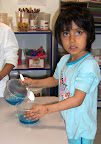
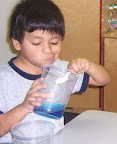
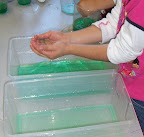.jpg)
While the children are engaged in the work of moving water I make comments about how scientists do work and sometimes have to change their equipment to make the work easier. During the hour I offer to trade tools with the children, showing first some laundry and baby formula scoops, and later, eye droppers and pipettes, baby nasal aspirators, syringe/irrigators, and pumps from liquid soap containers (supported with a surrounding clear plastic tube). The conversation expands along with the variety of tools.
As the children work, the teachers ask how they get the water to move, what tool is working “best,” and what is “pulling” the water down into the container from the spoon. The children demonstrate how they lift the water, or push and pull, or squeeze and release, the tools. Teachers introduce the word “force” and ask, “Which tool requires the most force to use? Which tool do you have to use the most muscles to move?”
The large laundry scoop is often seen as the best tool by all the children at first, but those at the tall container stations discard it in favor of droppers as the water level gets near the bottom. Children with poor motor skills do not favor the pumps which need two hands to secure and operate.
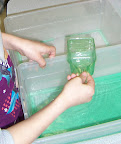.jpg)
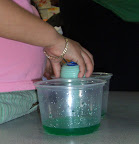
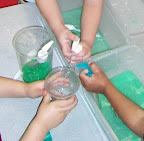.jpg)
The activity ended with a group recording session, marking tallies on a chart to show which tool they liked the best. A second chart was marked to show which tool the children thought moved the “most” water. Some children choose the tool that moved the largest amount of water at one time, others picked the tool that seemed to move water the fastest, and of course some just chose the empty section on the chart or the same section their friend picked.
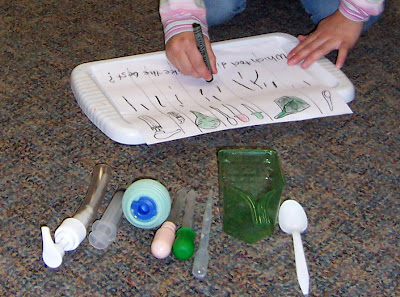
Repeating the activity with an emphasis on measuring would help the children realize that “the most” can be quantified.
What are your ideas for water exploration—indoors and out?
Peggy
I’m looking for ideas on how children can move water in different ways outdoors when the weather warms up. Ideally we’d have a shallow, slow-moving stream of pristine water nearby….
Unforgettable, in every way
By Debra Shapiro
Posted on 2009-03-22
For me, New Orleans will be “unforgettable, in every way,” to quote the old Nat King Cole ballad. I feel as though I left a part of my heart there. It was a privilege to be able to visit the Crescent City, and I thank NSTA for it.
I also will never forget all of the wonderful science educators I met and chatted with each day. Here are six of them who graciously shared their impressions of the conference and allowed me to photograph them.
—Debra Shapiro
 |
Being a [science] coach, I work with a lot of teachers. So from NSTA, I would say that at this conference, I’ve gotten a lot of information for myself as far as professional development with coaching and the different models that different states actually use. So I will take that back and share [it] with the other coaches. Then for teachers, [I’ve received] a lot of hands-on activities that they can use, a lot of information about how to scaffold lessons for English-language-learner students, because we have a big population of those students that we are now learning that we need to service much better.
Charity Lawson, Landover, Maryland |
|
I have been very impressed with the sessions this time. I’ve had a lot of trouble singling out one session for each time slot: I have to narrow it down from about 20.
Mary Lara, Flagstaff, Arizona |

|
 |
This is my first NSTA conference. I’ve heard about them quite a bit; wasn’t quite sure what to expect. It’s been a great experience so far. I attended a lot of workshops based on technology and sort of in that realm, and I learned quite a bit from those…a lot of different project ideas to take back to my classroom…Getting a chance to really learn how to set up a web page and how to have students interact within a web page was wonderful.
Jonathan Ryberg, Astoria, New York |
|
As a person new in a district-wide position, coordinating science education [while] out of the classroom, I approached this conference a little differently than previous ones I’ve come to. I’ve tried to focus on sessions that were more general rather than subject-specific, and so I have been looking for pedagogy and practices and things that make sense in the classroom—best practices in the classroom—and I found a lot of that.
Gary Fortenberry, Lubbock, Texas |
 |
 |
As a [graduate] student, the opportunity to be able to go at a greatly reduced rate was really what spurred me on to be able to go, because otherwise I probably couldn’t have afforded it.
Robin Reiner, Billerica, Massachusetts |
|
I bought some really cool stuff. Lots to see. I drooled over a couple things I’m going to order when I get home, I think. And I got a bunch of things for writing grants and things like that…I teach biotechnology, and there’s tons related to what I teach—that’s even better than what I expected.
Claire Salier-Hellendag, Spring, Texas |
 |
For me, New Orleans will be “unforgettable, in every way,” to quote the old Nat King Cole ballad. I feel as though I left a part of my heart there. It was a privilege to be able to visit the Crescent City, and I thank NSTA for it.
I also will never forget all of the wonderful science educators I met and chatted with each day. Here are six of them who graciously shared their impressions of the conference and allowed me to photograph them.
—Debra Shapiro
Next year in Philadelphia!




